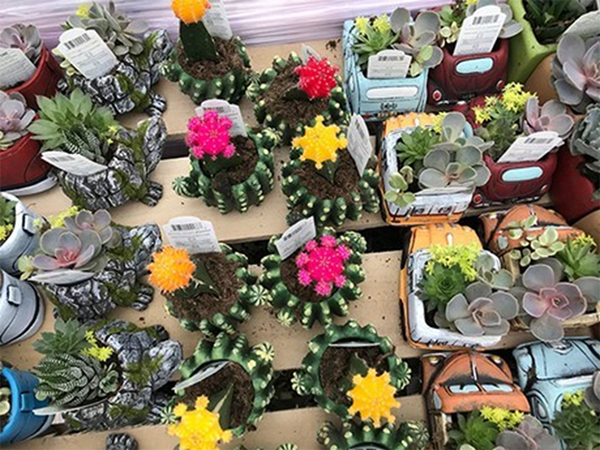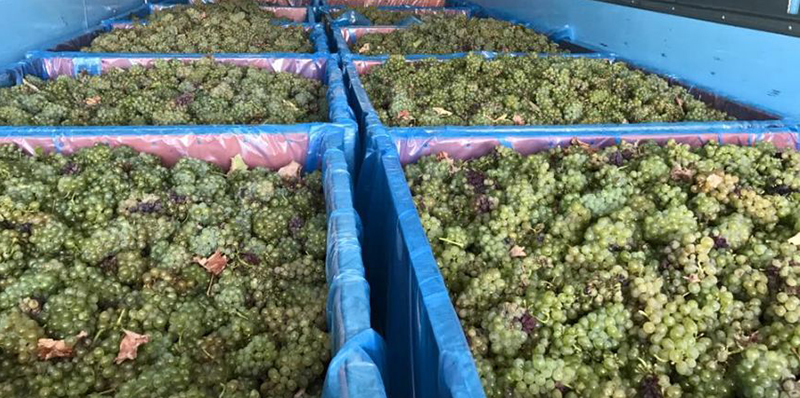Some of South Australia’s wine grape growers have seen their yields halve, as hot, dry conditions take their toll on some of the state’s wine regions.
However, many grape growers have reported being happy with the quality of the wines in spite of, or perhaps even because of, the tough conditions.
Clare Valley Wine and Grape Association executive officer Tania Matz said fans of Clare Valley wines should put in orders as soon as possible to avoid missing out, because there would not be much around.
“We’re estimating yields to be down 30–40 per cent on some varieties,” Ms Matz said.
“More susceptible varieties will be a much higher percentage down on last year, but overall we’re reporting we’re about 30–40 per cent down on average.”
Jim Barry Wines winemaker Tom Barry said there was little moisture in the soil due to the lack of rain over the past 12 months, which created problems for growers.
“It’s had a huge effect after a very dry winter and dry spring as well. There’s not a lot of subsoil moisture for the grapes to grow but the fruit we’ve had so far is really good,” he said.
“Riesling is really sturdy, that might only be 20 per cent down. Shiraz and cabernet were between 30 and 40 per cent down.
“That’s just the nature of the beast, that’s wine growing and we deal with that.”
Mr Barry said the talk around older grape growers, like his father Peter, is that no-one has seen dry conditions in Clare like this since 1982.
However, Mr Barry said vintages like this were the reason his family business invested in the Coonawarra region in the state’s south east 20 years ago.
“Really we went down for seasons like this where Clare has a small crop, but Coonawarra has had plenty of rain and that’s going to be looking really, really good,” he said.
In the Barossa, Yalumba head of winemaking Louisa Rose said yields were down about 20 per cent, but that recent vintages had been very good.
“Our yields do vary quite a lot from vintage to vintage,” Ms Rose said.
“Since 2015 we’ve had some higher-than-average yields and the quality has been good as well, so this may be the correction we needed to have.”
Winemakers must wear losses
In the Clare Valley, Stone Bridge Wines owner Craig Thompson said he had seen all the water sources on his properties dry up.
“We’ve got three dams across a couple of vineyards and we have had no water in them over [last] winter,” he said.
“The bores looked okay until mid-January, then they started slowing down and then [there was] no flow at all for us there.”
Mr Thompson said his riesling vines handled the heat a lot better than his shiraz plantings, which he called a “sooky grape”.
However, he said consumer demand for shiraz outweighed the difficulty in growing it in dry conditions.
“A lot more people drink shiraz than riesling even though riesling does well and we’re the riesling capital of Australia, but shiraz is what many people drink,” he said.
Despite the downturn in yields, Mr Thompson said winemakers could not just put up their prices to recoup the losses.
“We’ve just got to fake it for a while, I suppose,” he said.
“We have a pretty diverse business where we make some bulk wines as well as our own label. Things are going to be down a little bit, but we’ll just struggle through and hope for some rain.”
Just four hours to cut yield in half
For Port Lincoln’s Boston Bay Wines it was only a matter of hours, not days, that saw up to 50 per cent of the crop diminished.
Winery manager Tony Ford said they suffered during the extreme heatwave in January and, despite doing everything they could in the lead-up, the grapes just could not handle the heat.
“We were given plenty of warning that it was going to be full-on. I think Port Augusta broke the state record that day and we got to 48 degrees here in Port Lincoln,” he said.
“We watered and we put on some sun protection and we had the bottom of the vines all fluffy and not radiating it back up as much as it could.
“But by one o’clock we knew we were in big trouble.”
Mr Ford said the riesling was the hardest hit.
“That had quite a bit of liquid in it at that stage and wasn’t far off from being picked and we probably lost a good 60 per cent of that, which is heartbreaking — especially for my brothers who do the most work on the vineyard,” he said.
“The sauvignon blanc handled it a little bit better and we maybe lost 20 per cent of that.
“And the reds, that didn’t have a very good flowering to start with, were three or four weeks behind with moisture in the berries, so they handled it quite well,” Mr Ford said.
Quality on the way
Mr Ford said, despite the low yields, the grapes that were picked were of the highest quality he could ask for.
He said it was because there were not as many grapes left on the vines.
“Some wineries might ask vineyards to drop fruit up to six weeks out, so they actually will cut off perfectly good grapes just so the vine concentrates and really puts the effort into the remaining grapes,” he said.
“So in effect, because it was sort of a month before we picked, those berries dried off and died and so the same principle applies.
“This is exactly what happened in 2014 when we won the Wine State Riesling of the Year, it was the ugliest fruit we have ever picked, but we are not in a photography competition, we are after the juice and that is what the winemaker can work with.
“So there won’t be a lot of wine, but we are positive it will be top quality.”
Also in Port Lincoln, Peter Teakle Wines lost some yield during the high 40-degree days, but viticulturalist Andrew Blackberry said their location helped to protect the grapes a bit from the heat.
“Our riesling was also the big one affected for us, but the rest fared quite alright because we had enough canopy there to shade the fruit from sunburn or anything like that,” Mr Blackberry said.
“But compared to areas like around Adelaide, who were on average down about 40 per cent, we did okay with only a drop of about 15 per cent and our quality is still going to be really good.”
Some of South Australia’s wine grape growers have seen their yields halve, as hot, dry conditions take their toll on some of the state’s wine regions.
However, many grape growers have reported being happy with the quality of the wines in spite of, or perhaps even because of, the tough conditions.
Clare Valley Wine and Grape Association executive officer Tania Matz said fans of Clare Valley wines should put in orders as soon as possible to avoid missing out, because there would not be much around.
“We’re estimating yields to be down 30–40 per cent on some varieties,” Ms Matz said.
“More susceptible varieties will be a much higher percentage down on last year, but overall we’re reporting we’re about 30–40 per cent down on average.”
Jim Barry Wines winemaker Tom Barry said there was little moisture in the soil due to the lack of rain over the past 12 months, which created problems for growers.
“It’s had a huge effect after a very dry winter and dry spring as well. There’s not a lot of subsoil moisture for the grapes to grow but the fruit we’ve had so far is really good,” he said.
“Riesling is really sturdy, that might only be 20 per cent down. Shiraz and cabernet were between 30 and 40 per cent down.
“That’s just the nature of the beast, that’s wine growing and we deal with that.”
Mr Barry said the talk around older grape growers, like his father Peter, is that no-one has seen dry conditions in Clare like this since 1982.
However, Mr Barry said vintages like this were the reason his family business invested in the Coonawarra region in the state’s south east 20 years ago.
“Really we went down for seasons like this where Clare has a small crop, but Coonawarra has had plenty of rain and that’s going to be looking really, really good,” he said.
In the Barossa, Yalumba head of winemaking Louisa Rose said yields were down about 20 per cent, but that recent vintages had been very good.
“Our yields do vary quite a lot from vintage to vintage,” Ms Rose said.
“Since 2015 we’ve had some higher-than-average yields and the quality has been good as well, so this may be the correction we needed to have.”
Winemakers must wear losses
In the Clare Valley, Stone Bridge Wines owner Craig Thompson said he had seen all the water sources on his properties dry up.
“We’ve got three dams across a couple of vineyards and we have had no water in them over [last] winter,” he said.
“The bores looked okay until mid-January, then they started slowing down and then [there was] no flow at all for us there.”
Mr Thompson said his riesling vines handled the heat a lot better than his shiraz plantings, which he called a “sooky grape”.
However, he said consumer demand for shiraz outweighed the difficulty in growing it in dry conditions.
“A lot more people drink shiraz than riesling even though riesling does well and we’re the riesling capital of Australia, but shiraz is what many people drink,” he said.
Despite the downturn in yields, Mr Thompson said winemakers could not just put up their prices to recoup the losses.
“We’ve just got to fake it for a while, I suppose,” he said.
“We have a pretty diverse business where we make some bulk wines as well as our own label. Things are going to be down a little bit, but we’ll just struggle through and hope for some rain.”
Just four hours to cut yield in half
For Port Lincoln’s Boston Bay Wines it was only a matter of hours, not days, that saw up to 50 per cent of the crop diminished.
Winery manager Tony Ford said they suffered during the extreme heatwave in January and, despite doing everything they could in the lead-up, the grapes just could not handle the heat.
“We were given plenty of warning that it was going to be full-on. I think Port Augusta broke the state record that day and we got to 48 degrees here in Port Lincoln,” he said.
“We watered and we put on some sun protection and we had the bottom of the vines all fluffy and not radiating it back up as much as it could.
“But by one o’clock we knew we were in big trouble.”
Mr Ford said the riesling was the hardest hit.
“That had quite a bit of liquid in it at that stage and wasn’t far off from being picked and we probably lost a good 60 per cent of that, which is heartbreaking — especially for my brothers who do the most work on the vineyard,” he said.
“The sauvignon blanc handled it a little bit better and we maybe lost 20 per cent of that.
“And the reds, that didn’t have a very good flowering to start with, were three or four weeks behind with moisture in the berries, so they handled it quite well,” Mr Ford said.
Quality on the way
Mr Ford said, despite the low yields, the grapes that were picked were of the highest quality he could ask for.
He said it was because there were not as many grapes left on the vines.
“Some wineries might ask vineyards to drop fruit up to six weeks out, so they actually will cut off perfectly good grapes just so the vine concentrates and really puts the effort into the remaining grapes,” he said.
“So in effect, because it was sort of a month before we picked, those berries dried off and died and so the same principle applies.
“This is exactly what happened in 2014 when we won the Wine State Riesling of the Year, it was the ugliest fruit we have ever picked, but we are not in a photography competition, we are after the juice and that is what the winemaker can work with.
“So there won’t be a lot of wine, but we are positive it will be top quality.”
Also in Port Lincoln, Peter Teakle Wines lost some yield during the high 40-degree days, but viticulturalist Andrew Blackberry said their location helped to protect the grapes a bit from the heat.
“Our riesling was also the big one affected for us, but the rest fared quite alright because we had enough canopy there to shade the fruit from sunburn or anything like that,” Mr Blackberry said.
“But compared to areas like around Adelaide, who were on average down about 40 per cent, we did okay with only a drop of about 15 per cent and our quality is still going to be really good.”









